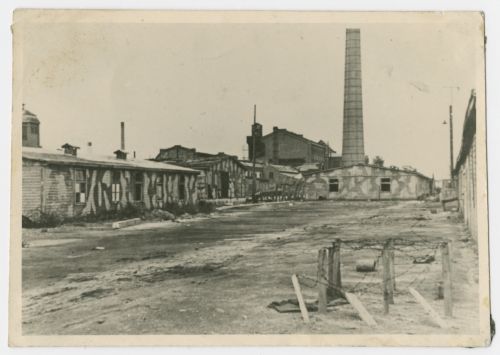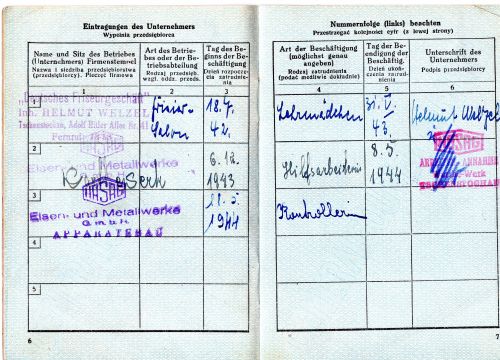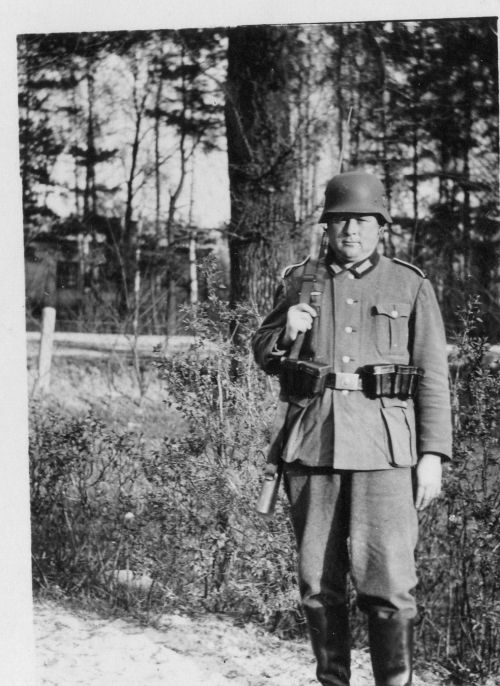HASAG

HASAG - Pelcery Camp (USHMM)
HASAG (Hugo Schneider Aktiengesellschaft) Leipzig, one of the privately owned German industrial companies manufacturing armaments that employed Concentration Camp prisoners. HASAG was the third largest after I.G. Farben, and Herman Goring Werke.
HASAG was founded in Leipzig in 1863, as a small lamp factory and became the Hugo Schneider Aktiengesellschaft in 1899, when it was converted into a metal products factory. In 1930, the company had about one thousand employees and an annual turnover of 5 million marks.
In 1932, Paul Budin a member of the Nazi Party and a Sturmbannfuhrer in the SS, was appointed general manager of HASAG. His deputies were Dr. Georg Mumme, Hans Fuhrer, and Gustav Hessen; Dr Ernst von Schon was chairman of the board. and the shareholders included Hugo Zinsser, Ernst von Wildeneg and Richard Koch.
Beginning in 1933, the company developed contacts with the Infantry Ordinance branch of the Wehrmacht High Command and it became a regular supplier of ammunition to the infantry and the Luftwaffe. In 1934, HASAG was classified as a Wehrmachtsbetrieb. By 1939, its annual turnover was 22 million marks and it employed thirty-seven hundred workers.
HASAG's status was raised to that of Rustungsbetrieb (Armaments Company) in 1939. When the German armaments industry was re-organised in 1940, Budin was appointed the chairman of the Special Committee II, which had the task of supervising the production in the Reich of light ammunition for the infantry and the air force. When Albert Speer was appointed Minister of Armaments in 1942, the committees range of responsibilities was broadened and Budin's stature also grew as a result.
In 1944, HASAG was charged with the mass production of infantry rocket launchers and received Hitler's thanks for its achievements. HASAG- Leipzig was also singled out as an 'Exemplary National Socialist Enterprise.'
During the war HASAG had eight plants in Germany, with two categories of workers. The first was that of civilian workers, men and women from all over occupied Europe, especially the Slavic countries. Some chose to work for HASAG, but the majority were forced labourers. By 1941, HASAG was employing a large number of Polish and Croatian voluntary workers and in subsequent years it also employed French and Russian workers. Special open camps were established in the vicinity of the plants for the slave workers, but they were kept under strict police surveillance. The pay for these workers was very low.
The second category was that of Concentration Camp prisoners. Beginning in the summer of 1944, labour camps were established next to each HASAG plant, all of them Aussenkommando of the Buchenwald Concentration Camp. According to incomplete data based on the Buchenwald card index the composition and size of the work force in the HASAG labour camps on January 31st 1945, a total of 14,581 were employed.
The employment by the HASAG industries of such a large number of female forced labourers was determined by a number of factors:
1. The mechanisation and automation of the production of small- and medium -size munitions enabled women to replace men in the assembly line.
2. Women cost less than men. HASAG paid the SS less for women prisoners, both in Germany and the GeneralGouvernement
3. HASAG's experience with the Jewish forced labour, showed that, all other things being equal, women's adaptability and resilience were much greater than men's. The average mortality rate was higher for men than for women.
Between 20,000 and 22,000 prisoners of different nationalities passed through the HASAG labour camps in Germany from their establishment until their final liquidation in April 1945, with the advance of the Allied forces, some of the prisoners were transferred to other camps, whilst others who were put on death marches were dispersed in many small groups, and therefore no estimate can be made of the number of prisoners who died or were killed en-route. Between 70 -80 per cent of the Jewish prisoners in the HASAG camps may be presumed to have survived.

HASAG - Arbeitsbuch (Chris Webb Private Archive)
Following the German invasion of Poland in September 1939, HASAG began operating in the Radom district, in the central part of Poland. In 1940, on the recommendation of the Armed Forces High Command HASAG was put in charge of the administration of the ammunition factories in Skarzysko- Kamienna, the Granat grenade factory in Kielce and the Rakow foundry in Czestochowa. The three plants were also classified as Wehrmachtsbetrieb. Early in 1943, HASAG acquired the plants from the GeneralGouvernement, for a payment of 16.5 million Zloty.

Kielce - Guard at the Granat Factory (Chris Webb Private Archive)
After the invasion of the Soviet Union in June 1941, HASAG became the main supplier of ammunition to the GeneralGourvernement. Figures show that on February 1, 1942, HASAG was the largest employer among the 64 Wehrmachtsbetrieb in the GeneralGourvernement, with a workforce of 13,850, mostly Poles. Of these 10,267 worked at the Skarzysko- Kamienna factories, 1,379 at Granat and 2,204 at the Czestochowa foundry.
In the spring of 1941, HASAG began transferring its Polish workers in the GeneralGourvernement to its factories in Germany. In 1942, when absenteeism became rife among the Polish workers, HASAG set up two Labour Training Schools in Skarzysko- Kamienna and Kielce. The prevailing shortage of workers led to an agreement between the Inspectorate of Armaments and F.W. Kruger, HSSPF-Ost, for the employment of Jews in the armaments industry. Under this agreement signed on October 12, 1942, six forced labour camps were established by HASAG, in the vicinity of Radom. Jews from Poland, Austria, Czechoslovakia, Germany and Hungary were imprisoned in them and put to work in armaments plants.
The average number of prisoners in the HASAG labour camps and the total number of Jewish prisoners who passed through them, in total:
Skarzysko- Kamienna - 25,000 - 30,000
Granat - 800
Czestochowa Apparatesbau - 7,000
HASAG Czestochowianka - 2,000
HASAG Warta - 2,000
HASAG Rakow - 500
In late June 1943, the HASAG forced-labour camps held approximately 17,000 Jewish prisoners, 6,408 of them in Skarzysko- Kamienna.
For each Jewish prisoner in the labour camps, HASAG paid 4 to 5 zloty per day, less maintenance costs, into the account of Herbert Botcher, the SS und Polizeifuhrer for the Radom district.
The prisoners living conditions differed from one camp to another, depending on the attitude of the factory manager. In general the policy of extermination through work was applied, and in all the camps 'Selektionen' were carried out from time to time, culminating in the killing of all those who were no longer considered 'fit for work'.
From July 1944, until early 1945, HASAG transferred to Germany most of the equipment and raw materials it had in its factories in the GeneralGourvernement, together with groups of Polish workers. After the final 'Selektionen' most of the remaining Jewish prisoners were also moved to HASAG factories in the Reich.
Paul Budin is assumed to have committed suicide, together with his wife, in April 1945, when he blew up the company's head office in Leipzig. The personnel who were employed by HASAG were not put on trial in Nuremburg, after the Second World War ended.
Source
Encyclopedia of the Holocaust, Macmillan Publishing Company NY, 1990
Photographs: USHMM and Chris Webb Private Archive
Document: Chris Webb Private Archive
© Holocaust Historical Society, July 3, 2021
T

